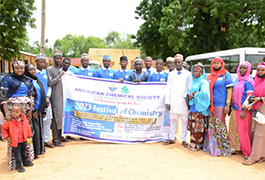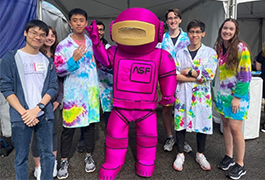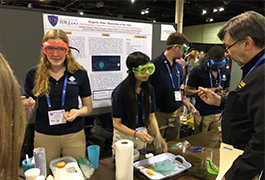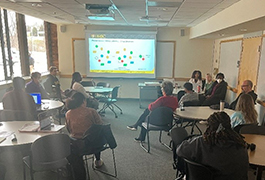Take Your Chapter to the Next Level with Green Chemistry
Last updated 8/31/2021

Let’s be honest—chemistry is not always environmentally friendly. From syntheses that require liters of chlorinated solvents to raw materials that must be dredged out of the earth, some of the traditional approaches to chemistry have been rough on the environment and even people.
For example, phenol, a key starting material for plastics, was originally produced by reacting benzene, sulfuric acid, and sodium hydroxide in a multistage process. The process had a yield of 82% but relied on dangerous reactants and produced excessive amounts of sodium sulfite.
In recent years, chemists have turned their attention to green chemistry to reimagine the practice of chemistry for a more sustainable future. This involves asking chemists and engineers to design chemicals, chemical processes, and products in a way that is both most efficient and that produces the least pollution and waste. So now benzene is reacted with propene and oxygen to produce phenol and acetone, which has multiple industrial and consumer uses; the process uses more environmentally friendly reactants and produces far less waste.
As future scientists, you can and should bring these principles into your own practice of chemistry. And what better place to start than with your ACS student chapter?
What is green chemistry?
Green chemistry changes how chemistry is done. Chemical products and processes are designed so that they use and produce fewer—or even no—hazardous substances. Green chemistry is based on 12 design principles that encourage chemists and engineers to use resources more efficiently, minimize hazards and pollution, and consider the long-term implications of their choices.
All too often in the past we made wonderful substances, but at the end of their usefulness, the only option was to put them in disposal sites. When we plan, manufacture, process, use, and dispose of chemical products, there is an impact on human health and the environment. With green chemistry, the idea is to prevent pollution and other unintended consequences before they occur.
Chemists who apply green chemistry practices also take into consideration the financial impact of environment degradation and damage to plant and animal health. Crucial to sustainability is calculating socioeconomic implications of sourcing materials, the relative abundance of feedstocks (some technologically important elements are quite rare and found in politically and economically unstable areas), and what happens to materials once they become waste.
It is difficult to calculate these costs, but not impossible. The price of a quart of gasoline is cheaper than the cost of a liter of bottled water. But what happens when we factor in all the costs for mitigating pollution, treating disease, and dealing with environmental changes that occur once we burn the gasoline in automobiles? If these repercussions were included in the price at the pump, filling up a tank would be much higher.
Ultimately, the goal is to develop practices that permeate science, so that the practice of chemistry becomes inherently green.
Why should ACS student chapters go green?
If you are part of an ACS student chapter, you already know that this extracurricular activity contributes to your education and your professional growth. You develop organization, teamwork, leadership, communication, and other professional skills with each activity you plan and execute.
Industry, academia, government, and other employers are placing increasing importance on sustainability. So anything you can do to develop sustainability skills will help you when you enter the workforce. This includes incorporating green practices into your ACS student chapter.
“Green” ACS student chapters engage in green chemistry outreach activity, become advocates for the idea of sustainable chemistry in their communities, and work to inspire the next generation.
“Our student chapter has seen times of great involvement and times of dormancy, just like at other colleges and universities,” says Irv Levy, a chapter faculty advisor at Gordon College. “But the integration of green chemistry transformed the past six years into our chapter’s most successful years.”
In honor green chemistry efforts and initiatives by student chapters, the ACS Green Chemistry Institute recognizes green student chapters with the ACS Green Chemistry Student Chapter Award. Gordon College is one of 59 student chapters that received a green chemistry chapter award based on activities reported in their student chapter reports.
Just remember that when you’re submitting your chapter report, environmentally focused activities such as river cleanups, recycling drives, and water analysis do not involve changing the ways in which chemicals are produced and used, so they are not considered green chemistry activities.
How does a chapter go green?
Here are five ways to help you chapter go green.
- Embrace activities that are inherently greener. In many cases, greener chemistry activities are also safer. If your chapter does outreach activities, greener practices ensure a safer learning environment for your audience, and they provide a positive impression of chemistry as a field. Explaining the environmentally friendly aspects of your chemistry can also teach a lesson in sustainability.
- Invite experts in green chemistry to be guest lecturers. Consider inviting people who are researching or practicing green chemistry. To raise the profile of green chemistry, invite not only chemistry students and faculty, but also education majors, business majors, local high school teachers, or community environmental club members.
- Take field trips to tour companies or agencies doing green chemistry. You might be able to find local enterprises that are involved in making their practices more sustainable. Get ideas for tours by checking out the recipients of the Presidential Green Chemistry Challenge Award.
- Serve your department by developing greener versions of a lab from your current undergraduate curriculum. You could also do a life cycle analysis for a current lab or consider the scarcity of elements when making choices for current labs. Advocating for greener approaches can be a powerful force for change.
- Set up displays in public areas to teach others about green chemistry. Public displays (e.g., bulletin boards, fairs, parks, campus events) are great ways to creatively explain the purpose for green chemistry and recent advances in its application.
What resources are available to help chapters go green?
The ACS Green Chemistry Institute website is full of resources and ideas for student chapters, including activities and how-to guides.
To learn more about applying green chemistry principles and advocating for more sustainable practices, check out Greening the Lab (and Beyond!), a practical guide to applying green chemistry, and Beyond Benign, an organization that develops and disseminates green chemistry and sustainable science educational resources. The Beyond Benign website contains a wealth of information for all grade levels. It also has information on how to become a College Student Fellow, a program that seeks to empower undergraduate students to be green chemistry ambassadors.
The American Chemical Society is committed to improving people’s lives through the transforming power of chemistry. As part of an ACS student chapter, you have the power to use chemistry to transform the way we source, manufacture, and dispose of the products that improve our lives.





